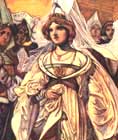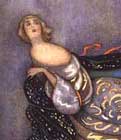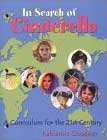
Cinderella:
345 Variants
by Marian
Roalfe Cox
SurLaLune's
Cinderella Area
SurLaLune Fairy Tales Main Page
298
Schott (Arthur und Albert), Walachische Märchen. Stuttgart und Tubingen, 1845. Story No. IV, pp. 100-105.
"THE PRINCESS GOOSEGIRL."
ABSTRACT
Ill-treated heroine (by step-mother). She is imprisoned and starved; after three days step-mother sends her jug of water containing young snake, which heroine swallows unawares. It grows inside her--Outcast heroine-- Father gives her twelve costly dresses, all of which she must wear under wooden cloak-- Heroine disguise--Menial heroine (goose-herd at palace)-- Reapers see her take off disguise and dresses to bathe; report to prince, who watches from behind hush. Sees her fall asleep after bathing and huge snake crawl out of her mouth. Throws his ring at it; drives it away. Heroine picks up ring on waking. Is met presently by prince and asked about ring on finger. She would restore it to him but he begs her to keep it arid become his wife. They are married secretly without king's consent. Heroine still wears disguise--Meeting-place (church) -- Twofold flight--Watch set at church doors on third day by prince's father, who would discover who unknown beauty is. Prince presents her to him as the goose-girl, his wooden bride--Happy marriage (celebrated)--Heroine's father invited--Villain Nemesis (step mother).
TABULATION
(1) An emperor's beautiful daughter has jealous stepmother, who, wishing to be rid of her, urges father to get her married. Heroine does not wish this, and father is unwillingly to part with her.-- (2) During his absence stepmother locks her up, giving her nothing to eat or drink for three days. On the fourth day she sends her a small piece of bread and a jug of water, in which she has thrown a young snake. Heroine, dying of thirst, swallows snake unwittingly.1 Henceforward she gets food and drink enough, though still a prisoner. Snake grows rapidly. Father returns, and stepmother calumniates heroine, who in vain protests her innocence and tells of her imprisonment.-- (3) Father loves heroine too dearly to order her death, but tells her to go forth and never see him more, he has twelve handsome dresses made for her, all of which she must put on, and outside all a mantle of wood. This she does, weeping, whilst wicked stepmother secretly rejoices.-- (4) hunger drives heroine out of forest into town, where she applies for service at palace of another emperor. Servants laugh at her appearance, and say emperor does not employ wooden people. Prince passes by, and, marvelling at wooden dress, questions weeping heroine. She begs to be employed in some menial service, and he makes her gooseherd, and gives her room to herself, that other servants shall not ill-treat her.-- (5) Next day heroine drives geese into meadow, and at noon, when geese go into water, she takes off her clothes to bathe. Some reapers, whom she has not noticed at work near, watch her in great astonishment as she puts off her twelve gorgeous dresses, and at night they tell prince about wooden maiden.-- (6) Next day prince hides in a bush, and heroine bathes in same spot as before. He is entranced with her beauty. This time, in resuming clothing, she leaves off six of the dresses, meaning to carry them home, as the heat is so great. She is very thirsty, but does not like to drink of water in which she has bathed. Perhaps to forget her thirst, she lies down under shadow of a tree, and falls asleep. Then prince sees from between her half- closed lips a hideous snake of great length crawl slowly forth. He is horrified, draws nearer, and throws gold ring at snake, hitting its head, and making it glide away and disappear. Heroine is aroused, and sits up, but does not see prince, who quickly hides. She thanks God for making her feel so well. Then she sees ring in grass before her, takes it, and drives geese home-- (7) Prince has hurried home shorter way, and meets her as she goes to her room after tending geese, and asks about ring on her finger. She answers, shyly, that it is a find. Prince says ring is his, for he lost it. She restores it to him, but he will not take it, and replaces it on her finger, saying, "Keep it, sweet child, for I will marry you!" Heroine blushes, thinking prince is mocking her, for how can a prince take a poor wooden girl to wife? He insists that he loves her just as she is, and entreats her to marry him; then hurries to emperor, who is enraged to hear he intends marrying gooseherd, and withholds consent.-- (8) Prince marries her secretly. Father is angry at hearing it, but assigns four rooms in palace for prince and heroine to occupy, though she remains gooseherd as before.-- (9) One Sunday, after she has driven the herd home, heroine dons one of her fine dresses, and goes to church, where all are struck with her beauty. Then prince asks father who is the lovely stranger, and when he does not know, says, "O father, why have you not such a lovely wife?" Service over, heroine returns unperceived in the throng, and resumes wooden mantle.-- (10) Next Sunday all happens as before; prince puts same question to father, who determines on the following Sunday to have people stationed at every door, to find out who lovely stranger is, whence she comes, and whither goes.-- (11) Thus when heroine tries to escape unperceived she keeps coming upon a watch, and in this way is left behind in the church alone. Prince says to father, "Send the watch away, for the lovely damsel is none other than the goose-girl, my wooden bride." Father is delighted, and embraces her.-- (12) He plans a ceremonious wedding festival, and invites his neighbour, the emperor, to his daughter's wedding. Heroine's father is overjoyed to meet her again, and learning her horrible treatment at hand of stepmother, sends orders for the latter to be instantly beheaded.
NOTES
Note 60
(P. 370.) I have found a curious variant of this incident in Eugen Prym und Albert Socin, Der Neu-Aramaische Dialekt des Tur' Abdin. Gottingen, 1881. No. XXII. Vol. ii, p. 75.
Heroine lives with married brother, whose wife calumniates her till he has her shut up in her room and bread and water taken to window. Wife one day puts snake in water-jug, and heroine swallows it unawares. It grows inside her. Brother, wishing to spare her from reproach, invites her to go riding with him, and takes her away to the mountains. She complains of thirst, and he bids her follow a bee which is passing at the moment, for it will lead her to where there is water. She is to drink and return to him; but meanwhile he rides off. She rides after the bee for two days, and then finds water. When she rides back her brother has gone. She dismounts, ties the mare to her feet, and goes to sleep. A prince who has been hunting finds her and speaks to her, but she does not answer. He takes her with him; and, as for two whole days she has spoken no word, he asks physician what is amiss with her. Doctor says she has a snake inside her. They must heat a cauldron of milk over the fire, and lay a sieve over the top, hang the girl head downwards over it, and the snake will fall from her mouth on to the sieve, and she will be able to talk. So it happens. One day, when heroine is at the well drawing water, she is carried off by a giant. She is eventually found and liberated by her brother, who in the meantime has killed his wife and set out to seek his sister.
Compare the way in which the alp luachra is enticed forth
in the Irish Gaelic story (Hyde, Beside the Fire, 65-67). Possibly
the snake in the Cinderella tale was attracted by the stream near which
the heroine lay down.
Return to place in text.
Cox, Marian Roalfe. Cinderella: Three Hundred and Forty-five Variants of Cinderella, Catskin, and Cap O' Rushes, abstracted and tabulated. London: David Nutt for the Folklore Society, 1893.
While the original text of this book is out of copyright, the special formatting and compilation available on SurLaLune Fairy Tales is copyrighted. Be aware that while the original content has been honored, page numbering, footnote numbering, redesigned charts, links, and other aspects are unique to this site's version of the text. Use at your own risk. For private and fair use educational purposes only.
©Heidi
Anne Heiner, SurLaLune Fairy Tales
E-mail: surlalune@aol.com
Page last updated February 1, 2006
www.surlalunefairytales.com










